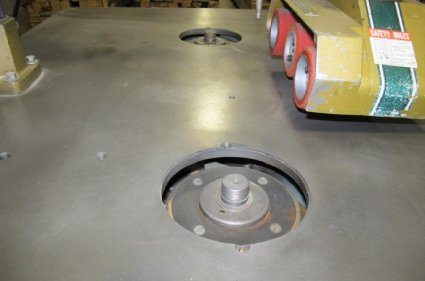Storing Moulder Knives
Shop owners trade ideas for keeping track of all those moulder knives. December 26, 2006
Question
What's a good way to store molder knives? I've got mine in labeled individual padded envelopes right now. Got to be a better way.
Forum Responses
(Cabinetmaking Forum)
From contributor J:
I just keep them in the white boxes that they come in, along with a 6" sample and the templates. Draw the profile on the end of the box and place them on a shelf. It's a simple solution, and you can readily see what you have.
From contributor D:
I had a tool room that was lined above the base cabinets with 8/4 poplar with 9/16" wide dadoes at a 30 degree angle cut into them. Picture a wall 7' wide by 3' high. A pair of knives would sit in these, profile up, and not hit each other and still show the profile for easy identification. This was safe and visual.
From contributor R:
There are many ways to do this. Here is just one way that comes to mind and works quite well. Make square pigeon holes about 5" or 6" wide and tall by 8" deep, the length and the height of your wall from the top of your bench. Now label across the top A, B, C, D, etc. Next, label down 1, 2, 3, 4, 5, etc. When you put a knife away, write on the paper or catalog the number and letter of where it is at. This will save a lot of time looking for things in the future. I hope that will give you some idea. I am sure others have some great ideas also.
From contributor T:
We use a large drawered cabinet to store the knives and templates. You have to get good commercial cabinets to do that because of the weight. We use Stanley Vidmar cabinets. But there are other brands like Lista that also work. Expensive to buy new, but can be had at auction or used at good prices. If you get the tool crib, 59" high with 10 or more drawers, you can store hundreds of cutters in the cabinet. Also keeps them dust free and easily accessible.
From contributor H:
Based on your location and humidity issues, you may want to wrap them in vapor phase corrosion inhibitor paper. This will eliminate any chance of rust and will also protect the cutting edges.
From contributor F:
I currently keep my knives in boxes with angled dados that keep the knives at an angle for easier viewing. I am thinking of switching to a system similar to the one contributor R uses. It's getting to where it is time consuming to find the knife I want by eye alone because there are too many and some are similar looking. My idea is to store each knife in a separate pigeon hole along with a labeled and numbered one inch long cross cut sample on the molding the knife cuts. I already have a log book like contributor R has that contains the molding name and number along with the gib number for that knife.
From contributor L:
We have about 600 sets and keep them in divided drawers. We scan them into the CAD system and then catalog them by type, size, etc. We can print catalogs to give repeat customers using the CAD drawings. Drawers are marked with the same information as catalog. The catch is trying to keep up with all the new ones that get made.
From contributor K:
If you have a CNC machine, you can do as I did and make a peg board system. I just bored a half sheet of plywood with 3/8" diameter holes 1" on center. Every time I add a new knife, I glue a set of dowels in to hold it. I mounted it on the wall next to my moulder (Shop Fox) so I can see every knife at a glance.
